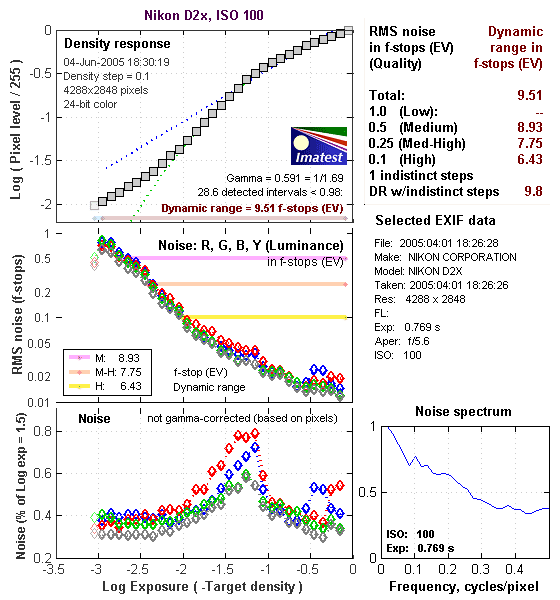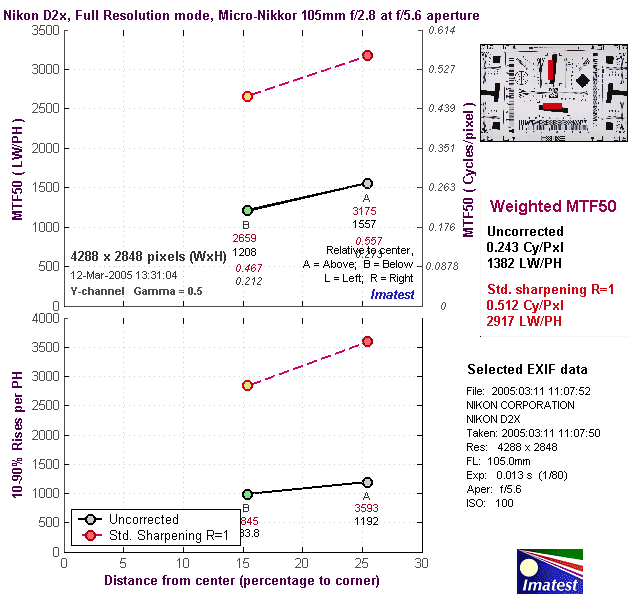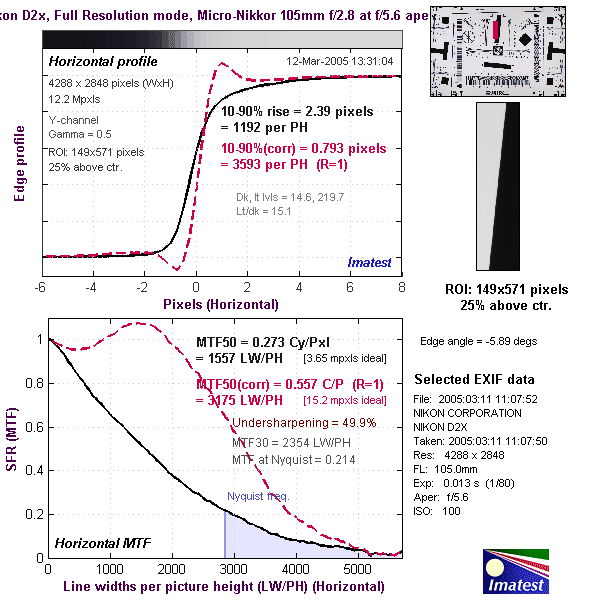Nikon D2XBy: Dave Etchells and Shawn BarnettNikon introduces a 12.2 megapixel hybrid pro SLR that can be either high resolution or high speed as the job requires. <<Reference: Datasheet :(Previous) | (Next): D2X Test Images!>> In-depth Image AnalysisReview First Posted: 04/14/2005, Updated: 06/10/2005 |
This page in our reviews is usually just a summary of test results from the Imatest image-analysis program. For the D2x though, I've expanded it quite a bit, to include the fairly detailed look that I gave that camera's images shortly after first getting my hands on a production sample. I've expanded the original coverage slightly here, to include some updated dynamic-range data from Imatest, using the latest version of that program (version 1.3.8), which better handles data from cameras like the D2x, which have very wide dynamic ranges.
You can see all the shots I'm basing my comments here on over at the Nikon D2x Photo Gallery page.
As I've begun doing lately, I printed out a number of the Nikon D2x's images at 13x19" on the Canon i9900 printer here in our studio. I've found that impressions from printed output can be different enough from those formed solely by looking at a CRT that we now routinely print a large number of photos from each camera we review on the 9900 as part of the review process. Some of my comments below will be based on what I saw in actual print samples, as opposed to on-screen inspection.
Resolution and Sharpening
My immediate impression was "That's a lot of resolution!" - The Nikon D2x's images showed a lot of fine detail, and held together very well at the 13x19" print size. I did feel though, that fine details were a tad soft, so took a look in Photoshop, to see how they responded to unsharp masking. What I found there was even more impressive - Using a radius of 0.3 pixels and strength of 150-200% revealed a lot of additional detail beyond what was first apparent. It appears that Nikon has been very conservative with the in-camera sharpening in the D2x, with the result that its images take post-capture sharpening very well. (More on this later.) Here's an example of what I saw, the crop on the left being untouched, directly as it came from the camera, the one on the right having been unsharp masked in Photoshop, at 0.3 pixels/200%. (By the way, this image was shot at a range of about 75 feet, using my Micro-Nikkor 105mm f/2.8 macro lens at f/8. This is an excellent lens with exceptional sharpness and practically zero distortion. I use it for any critical sharpness analysis with Nikon-mount d-SLRs.)
Color Accuracy
Color is obviously a key parameter, and for the most part, I'll leave you to make your own judgements based on the images in the photo gallery. The short of it though, is that the D2x's color is quite accurate, pretty near to being spot-on across most of the spectrum. I took a look at the MacBeth(tm) chart in the DaveBox target with Imatest, and found that it was a little undersaturated in the yellows and a little oversaturated in the blues, but believe that much of this was the result of a hue shift caused by the white balance being slightly off in the blue direction. If you took away that bias, I suspect that the actual/recorded color values would line up very closely. (I'd meant to repeat the DaveBox shots wit the production camera, but unfortunately neglected to do so before we had to return it to Nikon.)
The animated chart below shows the color accuracy results from Imatest, taken from shots at ISO 100, 800, 1600, and 3200. The point of showing color error plots across the full range of ISO values will be pretty evident if you watch what happens as the animation cycles through the four charts. The camera is pretty consistent across its "normal" ISO range of 100-800, but things start to go awry at ISO 1600, and deteriorate pretty dramatically at ISO 3200. What you can see happening is the color saturation falling off at the highest ISOs, something that I also observed in the Nikon D2H. (In Imatest's color error plots, the squares represent the actual color, while the circles show the value the camera captured. The center of the a*/b* coordinate system corresponds to zero saturation, the periphery to highly saturated colors. Thus, circles falling outside the associated squares represent oversaturated colors, and circles falling inside the squares show undersaturation. As you can see, the camera is quite consistent until we hit ISO 1600, and at ISO 3200, the saturation takes a dramatic hit. - No surprise then, that Nikon rates the D2x with a maximum ISO of 800.

Since we're talking about high ISOs, this is probably a natural place to look at the Nikon D2x's image noise characteristics. Perhaps thanks to its CMOS sensor, I found its images to be very clean, with very low noise levels, at least at lower ISO values. Here's a graph of how its noise-vs-ISO curve stacks up against some of the competition:

As you can see, the absolute magnitude of its noise levels are as good as those of any camera shown. As usual though, noise-magnitude plots of this sort actually tell us precious little about what the noise actually looks like. - I show them because readers like to see them, but do so almost under protest, as they actually bear little relationship to the visual impact the noise actually has. There's also the issue of how much detail the camera trades away in pursuit of low noise levels, something that such plots (or swatches of flat tints from a MacBeth chart) do nothing to reveal.
With that in mind, let's look at some crops from the same pine tree subject shown above, showing what happens as we go from ISO 100 to 3200:
I didn't bother showing samples from ISOs between 100 and 800, given that there wasn't a lot of deterioration in detail levels at ISO 800. (This speaks well for the performance of the Nikon D2x at ISO 800.) At ISO 1600, while the noise level is quite low, we can see that the camera is starting to trade off detail in regions of subtle contrast and color saturation, and at ISO 3200, the results are indeed very marginal.
I've shown this comparison because a lot of readers and potential users of the Nikon D2x will be very interested in its performance outside its "official" ISO range. In particular, sports shooters and photojournalists will often want to press the camera to the absolute limit of its ISO capability. At the same time though, I'm concerned that we not give a distorted view of the camera's image quality by focusing so much on its behavior outside its official ISO specification. - Within its normal ISO range, it produces very nice, smooth-looking images with a good tradeoff between low image noise and good subject detail.
It's also important to note again the difference between viewing images pixel-for-pixel onscreen, versus looking at prints. Looking at prints from our Canon i9900 studio inkjet, I was surprised by how usable the ISO 1600 shots were, even when printed at 13x19. At 8x10 print sizes, even the ISO 3200 samples looked surprisingly good. - If you're concerned about high-ISO noise in any digital camera you're considering, I strongly encourage you to download our test images and print them out on your own printer, to see for yourself whether the image quality is sufficient. - Don't fall into the trap of judging everything by what you see on your CRT, viewed 1:1.
Dynamic Range
Playing with Shawn's Gallery shots in Photoshop, one thing that really leapt out at me was the really exceptional dynamic range that the Nikon D2x shows. Monkeying around with Photoshop's Levels control, I found that could pull out absolutely amazing amounts of detail from deep, deep shadows. Here's one example (taken from the area under the stair landing in the shot of the back of the kayak store in the Photo Gallery):
In photo after photo, I was just flat-out amazed at how well the D2x held onto highlights, while at the same time preserving detail in deep, deep shadows. (It'd be interesting to shoot some comparison images with another camera body loaded with color negative film, to see just how the D2x would measure up to that standard. I suspect that the film+scanner combo would win on dynamic range, but the abilities of the D2x in this regard are really pretty impressive nonetheless.)
Dynamic Range in Imatest
Now that it fully supports the 13-stop Stouffer 4110 transmissive step scale, I've begun using Imatest to study dynamic range in cameras. The D2x is the first for which I'll be sharing results from the program, and it's a great one to lead off with, given its excellent dynamic range performance.

The chart above deserves considerably more explanation than I remotely have room for here: For all the details and exhaustive discussion of dynamic range measurement in cameras, I refer you to the Imatest site directly.
As noted, in my dynamic range testing, I use a Stouffer 4110 step scale, calibrated and certified with NIST traceability. This scale has 41 density steps in it, covering a 13-stop range in 1/3 f-stop increments. It's a transmissive target, so I illuminate it from behind with a tungsten light source, filtered to daylight white balance (in this case ~5300 K). For a test of this sort, it might be OK to use a fluorescent source in the 5000 - 5500K color temperature range, because we're not so concerned about rendering color. I still went with filtered incandescent though, because the spectral peaks of fluorescent light sources could affect noise levels and thereby introduce small errors in the computed dynamic range numbers.
The most important plot here is the log-log plot of pixel brightness vs density. The subtle "S" shape of this curve should be familiar to anyone who's looked at DlogE curves for film back in the "old days," as the data that's being shown is pretty exactly analogous. With data spanning such a wide range of values like this, it's important to use logarithmic axes on the plot in order to be able to see what's going on at the extremes. (Plotting the pixel brightness values on a linear scale results in curves that are essentially useless at the dark end of the curve, corresponding to shadow detail. They can also miss important data at the highlight end as well, although the response curves of most digital cameras aren't nearly as compressed in the highlights.
What this plot is showing us is the exceptional capability of the D2x to hold onto shadow detail, as well as a very nice, well-behaved rolloff of contrast as you move into the highlight area. One thing that's nice about Imatest for evaluating dynamic range in digital cameras is that it provides a very precise measurement of dynamic range, based on a mathematical curve-fit to the brightness/density data. In the case of the D2x, the dynamic range works out to a weighted average of 9.51 f-stops, a really excellent number.
What's probably more relevant to actual usage than the absolute limit of a camera's dynamic range though, are the numbers that Imatest calculates for usable dynamic range for "Medium" and "Medium-High" quality levels. - These numbers take into account the effect of noise, setting a threshold of a half-stop or quarter-stop of noise amplitude respectively as the allowable amount. While the absolute limit of the D2x's ability to discriminate shadow detail may be of interest to imaging geeks, the practicing photographer will be more concerned about how much he/she can crank up gamma in the shadows before noise becomes too much of a problem. By that measure, the D2x can deliver about 8.9 stops of dynamic range if you're willing to accept a moderate amount of noise in the shadows, or 7.75 stops if you want to keep things pretty clean. (Or 6.43 stops if you're an anti-noise fanatic.) As noted, these are all very good numbers, ones that will become more meaningful as we continue to use Imatest to characterize d-SLRs, and have more data to compare them with. (On a practical basis though, as shown in the image crop we discussed just previously, the D2x retains really remarkable levels of detail in its shadows.)
Imatest Resolution Results
I guess this brings us around to the issue of resolution again. I also used Imatest to look at the res-target results. Visually, the D2x holds at least some detail in the ISO res chart all the way out to 2000 line widths/picture height. (This is the limit of the standard ISO resolution chart, I haven't shot my 2x chart with the D2x yet, but it looks to me like somewhere around 2000 lw/ph is about what it's going to come in at anyway.)
Looking at the test target with Imatest reinforced my earlier belief that the D2x uses very conservative in-camera sharpening. The raw resolution numbers from Imatest for uncorrected files straight from the camera were fairly modest, showing an average of 1382 LW/PH using its "MTF 50" criteria. (Which seems to correlate best with visual sharpness.) On the other hand, after normalizing for a standard 1-pixel sharpening operator, the average value jumped to 2917 LW/PH, a very high value indeed. What's up?

We can see what's going on if we look at the actual intensity profiles across an abrupt edge in a subject. The plot below shows the results for a vertical edge (and therefore, the resolution along a horizontal axis), taken from the ISO 12233 resolution target. What we find is that the default sharpening applied by the camera results in zero overshoot across the edge. (The black line in the graph below.) This means there are no sharpening artifacts to be found in the D2x's images, which in turn means that its files will take post-capture sharpening in software unusually well. The results of the standard 1-pixel sharpening operator applied by Imatest are plotted in red, showing the small over/under-shoot that you'd normally aim for in final image files, to maximize the perceived sharpness without obliterating fine detail. You can also see how extremely abrupt this modest sharpening makes the actual black/white transition, which is what produces the unusually high MTF 50 numbers in Imatest's output.

Bottom line, the Nikon D2x captures exceptional detail, wringing every last bit of information from its 12.2 megapixel CMOS sensor chip. The extent to which its images can be sharpened after the fact bodes very well for the ability to make huge prints from them. -- And this was borne out by my own playing around with images from the D2x and our Canon i9900 printer here in the studio. The i9900 "only" makes prints as large as 13x19, but when I printed carefully-sharpened crops of D2x images corresponding to prints at least twice that size, I was amazed by how well they held together. (I have to say that, in my own experience at least, the D2x's images pretty much equal those from the 16-megapixel Canon EOS-1Ds Mark II,despite its lower megapixel count.)
Reader Comments! --> Visit our discussion forum for the Nikon D2X!
<<Reference: Datasheet | D2X Test Images!>>

Follow Imaging Resource: